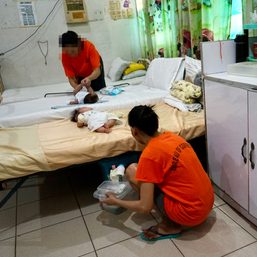SUMMARY
This is AI generated summarization, which may have errors. For context, always refer to the full article.
![[OPINION] Roe vs Wade reversal shifts abortion debate to in vitro fertilization](https://www.rappler.com/tachyon/2022/10/vitro-fertilization-october-11-2022.jpg)
Only weeks after the US Supreme Court overturned Roe vs. Wade, the abortion issue has segued to an even more contentious debate: in vitro fertilization (IVF).
Ironically, it was the abortion rights advocates in the US who were quick to point out the legal repercussions of the abortion ban on the practice of in vitro fertilization.
IVF is currently the most popular method of assisted reproductive technology. An estimated 8 million of the world’s population have been born through IVF.
In the Philippines, IVF started in 1995 and has since gained popularity. It is an expensive procedure with no guarantee of success, and there is no available data on the number of IVF procedures that have been performed nor the overall success rate.
How is IVF done?
IVF is only one among a number of scientific methods of helping childless couples who, for various reasons, are unable to conceive naturally.
The IVF procedure involves the collection of mature eggs from a woman’s ovary, which are fused with sperm on a petri dish for about two days, in a laboratory setting. A typical IVF procedure not only involves one egg, but several, so as not to have to repeat the expensive procedure when fertilization is not successful.
These fertilized eggs, now called embryos, are graded to determine quality and viability for continuing on to the more advanced blastocyst stage.
After this initial screening, an average of three fertilized embryos are chosen and inserted in the woman’s uterus. The remaining ones are either frozen for future use, donated for further study, or simply discarded.
The WebMD website says that half of IVF procedures in the US involve the transfer of two embryos; 23% involve three, and 10% involve four or five embryos at a time.
The Pacific Fertility Center in Los Angeles explains that when more than one embryo is transferred, one or all could successfully implant and there is a real chance of multiple births. In such cases, it is common to resort to what is referred to as pregnancy reduction – or abortion of fetuses.
In the US alone, there are 4 million IVF births every year. While there is no available data on the number of discarded embryos, it could be fairly deduced that the figures could equal if not rival the 65 million abortions that have happened since Roe vs. Wade was decided in 1973.
As modern science has established that human life begins at fertilization, it would appear that the practice of discarding human embryos in IVF procedures constitutes abortion.
The abortion ban and IVF
In the US, Oklahoma was the first state to implement a law that is said to be the strictest abortion ban, following the Supreme Court’s ruling against Roe vs. Wade.
According to an article published online by Politico Nightly: “Depending on the language and interpretation, a state law could curtail access to fertility treatments, and in some cases, make the practice of freezing or discarding unused embryos in IVF illegal.”
Seema Mohapatra, a health law and bioethics expert at Southern Methodist University, said the language could affect the practice of IVF in two ways, according to Politico. The first impact could be on selective reduction, or multifetal reduction, which is the practice of reducing the number of fetuses in one pregnancy.
Such procedures effectively terminate human embryos. The other one would be the initial selection process of which embryos to preserve for future use and which ones to discard.
A paper authored by Robert P. George and Patrick Lee titled Embryonic Human Persons – Talking Point on Humanity and Human Embryo Research, states that “embryological evidence shows that the human embryo is a whole, although obviously immature, human being, it is not a mere part.”
The papal encyclical Donum Vitae (Gift of Life) states that IVF is not acceptable because it “removes conception from the marital act and because it treats a baby as a product to be manipulated, violating the child’s integrity as a human being with an immortal soul from the moment of conception.” Donum Vitae teaches that if a given medical intervention helps or assists the marriage act to achieve pregnancy, it may be considered moral, but if the intervention replaces the marriage act in order to engender life, it is not.
John M. Haas, Ph.D., S.T.L. points out that Donum Vitae “did not judge the use of technology to overcome infertility as wrong in itself. It concluded that some methods are moral, while others – because they do violence to the dignity of the human person and the institution of marriage – are immoral.”
According to Haas there was a case in Canada where a couple wanted to have one baby via IVF. The doctor put five fertilized eggs in the mother’s womb without informing the couple. All five were delivered. The unknowing couple sued the doctor.
The author C. Ben Mitchell concludes: “Infertility can be very traumatic for couples. The array of reproductive technologies offered can be confusing. Decisions about which technologies to use take a great deal of mental, emotional, and spiritual effort. There are several important ways family and friends can help couples deal with infertility.” – Rappler.com
A businessman and veteran journalist, Chet Espino is a pro-life advocate.
Add a comment
How does this make you feel?


![[Dash of SAS] Making abortion a constitutional right](https://www.rappler.com/tachyon/2024/03/Its_true_-_Flickr_-_Josh_Parrish-1.jpg?resize=257%2C257&crop=125px%2C0px%2C768px%2C768px)


![[WATCH] Spoil me but respect me: A sugar baby’s story](https://www.rappler.com/tachyon/2024/03/titlecard-03.jpg?resize=257%2C257&crop_strategy=attention)

There are no comments yet. Add your comment to start the conversation.